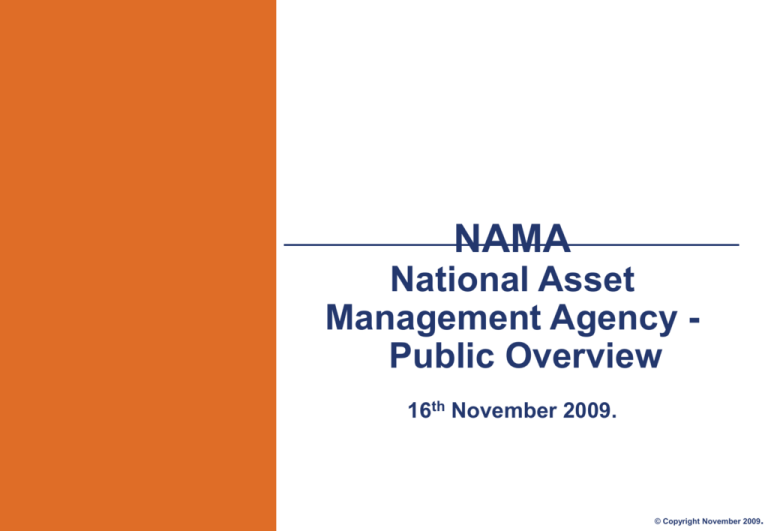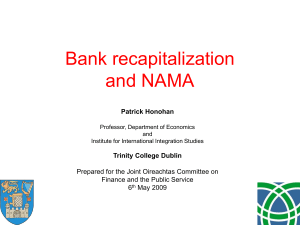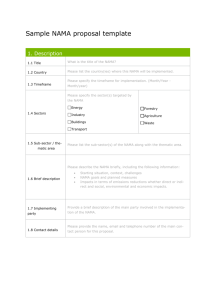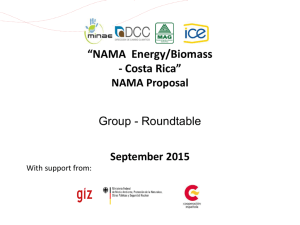Ireland_NAMA_Public Overview
advertisement

NAMA National Asset Management Agency Public Overview 16th November 2009. © Copyright November 2009. NAMA - National Asset Management Agency NAMA - What it is and what will it do? NAMA (the National Asset Management Agency) is the main engine of financial recovery for the banking sector as envisaged by the Irish Government. NAMA is an asset management company dealing with assets transferred from banks. NAMA will not be a bank as it will not be taking deposits from the public and will not have a banking licence. NAMA will have loans on its books based on real physical assets, and while some of these will undoubtedly be of better quality than others, they will be a mix of ‘good or performing loans’ and ‘bad or non performing loans’. Currently approximately 40pct of these loans are “performing loans”. What NAMA will do is buy all of the land and property development loans of the six Irish banks covered by the State guarantee. This means the total potential value of the loans which will be taken on by NAMA will be between €80 billion and €90 billion. By taking problem property loans from the banks, the Government hopes to put those institutions in a position where they can resume lending. NAMA will probably become the biggest landowner in Ireland. Developers might not yet realise it – but every single land and investment property they own which has outstanding debt could end up in the new National Asset Management Agency. © Copyright November 2009. NAMA - National Asset Management Agency NAMA – The Facts • Implementation of this initiative is absolutely necessary. • NAMA is NOT an Irish tax-payers' bail-out of the banks and the property developers that could saddle future Irish generations with long term debt. • The property developers will be the big losers and the banks will have to share the financial risk. • NAMA is firstly an “Asset Management company” dealing with assets transferred from banks. NAMA will not be a bank as it will not be taking deposits from the public and will not have a banking licence. • NAMA will have loans on its books based on real physical assets, and while some of these will undoubtedly be of better quality than others, they will be a mix of ‘good or performing loans’ and ‘bad or non performing loans’. In fact, a significant proportion of the assets which will be acquired are not impaired and approximately 40% of them are estimated to be cash-generating. • This is a complex business challenge - These complex Asset Management activities are best undertaken in a single accountable organisation that will derive significant benefit from standardised and consistent business processes, protocols, data sharing and workflows. NAMA is the correct vehicle for the management of these activities. This approach is backed by some of the world’s foremost economists – the foremost being the chief economist for Goldman Sachs. © Copyright November 2009. NAMA - National Asset Management Agency NAMA – Associated risks, accountability & reporting structures • NAMA is subject to the following Risks: Protracted valuation process, Valuations outside range, Economic risk, Prolonged property market depression, Money Market and Foreign Exchange Market risk, Foreign assets acquisition risk, Business strategy risk, Reputational risk and Staff risks. • NAMA will be accountable to demonstrate professional levels of operational control and operational efficiency in all areas of the operation. • NAMA will externally communicate on a regular basis in an efficient and fully transparent way. • NAMA will report to the Minister the following documents: Annual Statements, Annual Accounts & Quarterly Reports (The Minister will lay copies of this statement before the Houses of the Oireachtas.) • NAMA’s accounts will be audited by the Comptroller and Auditor General • The Chairman and Chief Executive Officer of NAMA will give evidence, whenever required to do so, to the Committee of Public Accounts and to any other Committee appointed by the Oireachtas to examine matters relating to NAMA. © Copyright November 2009. NAMA - National Asset Management Agency Economic background to NAMA In common with other countries, Ireland is experiencing major difficulties in its banking and financial sector. In particular, the capital markets have concerns about the adequacy of Irish banks’ existing capital to cover possible future loan impairments, in particular, impaired property loans, and the capacity of financial institutions to maintain adequate capitalisation. The initiatives taken by the Government to date in the form of the recapitalisation of AIB, Bank of Ireland and Anglo Irish Bank have not removed these concerns and are considered unlikely in themselves to achieve the capital adequacy ratios demanded by the international capital markets, given that it is also imperative that banks, at the same time, increase the flow of lending to stimulate economic recovery. In announcing the recapitalisation measures, the Minister for Finance stated that additional measures might be required to stabilise and strengthen the Irish banking system. To this end, the Government decided to establish the National Asset Management Agency (NAMA) which was announced in the Minister for Finance’s Supplementary Budget on 7 April 2009. Draft legislation to establish the new agency has been published (www.nama.ie) and extensive preparatory work has been undertaken by an interim NAMA team. © Copyright November 2009. NAMA - National Asset Management Agency NAMA - Breakdown of loans Breakdown of loans assumed (total €77 billion) in Ireland, UK and other foreign organisations: 1. 66.8% in Irish republic. 2. 20.7 in GB. 3. 6.2% in NI. 4. 2.7% in US. 5. 1.4% in Germany. 6. 0.7% in Portugal and same in France 7. 0.2% Czech Republic, Italy and Spain. 8. 0.3% in others. © Copyright November 2009. NAMA - National Asset Management Agency NAMA - Purpose and Business Objectives After four months of preparatory work and intensive drafting, the National Asset Management Agency Bill was published on 10 September 2009. The NAMA project is intended to address a serious threat to the economy and to the systemic stability of certain credit institutions. The Bill describes NAMA’s powers and functions as including the acquisition of certain bank assets, taking all steps necessary or expedient to protect, enhance and better realise the value of those assets and, by so doing, facilitating the restructuring, in line with EU Commission requirements, of credit institutions of systemic importance to the economy. The eligible assets to be acquired from participating institutions are land and development loans and associated loans. These pose the main systemic risk to the Irish banking system and their acquisition by NAMA is intended to ensure that bank balance sheets are cleansed of impaired assets. However, it should be noted that a significant proportion of the assets which will be acquired are not impaired and that about 40% of them are estimated to be cash-generating. It is important to note that the NAMA due diligence process will establish the bone fides of all data as part of loan valuation and transfer. © Copyright November 2009. NAMA - National Asset Management Agency NAMA - Purpose and Business Objectives NAMA will purchase bank assets through the issuance to participating institutions of a combination of Government securities or NAMA-guaranteed securities along with NAMA subordinated debt at a discount to the nominal value of loans being acquired. Subordinated debt will amount to 5% of the total amount of securities issued. Participating institutions may use the securities as collateral with the ECB and/or with market counterparties in order to obtain cash. It is expected that the resulting injection of cash into these banks should enable them to facilitate the flow of lending into the economy. NAMA’s commercial mandate is to obtain the best achievable financial return on the assets acquired by it. It will have all the necessary commercial powers of a financial asset management company to establish subsidiaries, to operate through agents, to buy and sell assets, to manage loans and work with borrowers, to borrow, to lend, to provide guarantees and to take whatever action it considers appropriate in relation to the debts owing and the underlying security. In order to enhance market liquidity and demand for its assets, NAMA will engage with domestic and international investors interested in opportunities to invest in one or more of its sub-portfolios. © Copyright November 2009. NAMA - National Asset Management Agency NAMA - Asset Valuation & Transfer process The current objective, which is dependent on the earliest possible establishment date of NAMA, is to have the largest 10-15 borrower exposures across the participating institutions transferred to NAMA by the end of the year. The transfer process will take place in tranches of borrowers and the aim is to have the process completed by the middle of 2010. It is estimated that the largest 100 exposures account for about €38 billion nominal value of the loans to be acquired by NAMA. The loan transfer process is illustrated graphically in Appendix 1. © Copyright November 2009. NAMA - National Asset Management Agency NAMA - Operating Structure & Organisation NAMA will maintain a streamlined organisational structure (see next page) and will outsource work as appropriate. It will employ a small team of professionals to oversee and manage the process in the interests of the taxpayer. • It is estimated that NAMA will have about 75 members of staff assigned to it who will oversee the management of its key functions. • Initially, it is expected that a core team of 30 will be required when NAMA is established to get the loan valuation and transfer process underway. It is envisaged that labour-intensive services such as loan administration, asset workout and property management will be outsourced to external service providers as appropriate. • The NTMA, as a service provider to NAMA, will need increased resources in the support functions of Financial Control, legal, funding and debt management and possibly IT to service NAMA but this has not been quantified as it is a matter for the Chief Executive of the NTMA to determine based on requirements set down by the NAMA Board. Structure • NAMA will have five business divisions, namely the Head of Portfolio Management, Head of Banking/Lending, Head of Credit and Risk, Head of Business Services and Head of Legal and Tax (an outline of the responsibilities of the five divisions is set out in the following page) © Copyright November 2009. NAMA - National Asset Management Agency NAMA - Organisation Structure © Copyright November 2009. NAMA - National Asset Management Agency NAMA - Key Risks in detail Many of the key risks faced by NAMA are outlined below. The NAMA Board and its Risk Committee will monitor these risks and ensure that appropriate risk management policies are in place. 1. Protracted valuation process – due diligence obligations, legal challenges and/or lack of preparation by institutions The risk that the transfer process takes significantly longer than currently projected and that, therefore, the injection of liquidity into the banking system and the corresponding flow of credit into the economy is delayed, in turn impeding economic recovery. Restoration of the availability of credit is a necessary precondition for the recovery in real estate prices required for NAMA to break even and, more generally, for an early recovery in economic conditions in Ireland. One source of risk is that institutions will not be sufficiently prepared in terms of data collation and this could lead to delay and disruption of the acquisition timetable. A further risk is the prospect of legal challenges to NAMA’s business operation which may delay and impede it in achieving its objectives. 2. Valuations outside expected range The risk that the bank asset valuation and acquisition process produces an outcome which is significantly different from current expectations with respect to the major parameters and assumptions set out below and used in the analysis to date: • The market value of the underlying property assets (€47 billion) • Interest rollup (estimated €9 billion) • Actual aggregate average LTVs (average of 77%) • The proportion of acquired assets which are cashflow-producing (40%) • Margins on income-producing assets (2%) • Default rate (20% assumed) © Copyright November 2009. NAMA - National Asset Management Agency NAMA - Key Risks in detail… 3. Economic risk The risk that, notwithstanding the availability of credit, economic growth in Ireland will remain sluggish for a protracted period in response to the impact of the budgetary tightening that began in 2008 and is likely to continue for the foreseeable future. The ESRI forecasts GDP contraction of 7.2% this year and 1.1% in 2010; the latter incorporates the effect of a moderate pick-up in economic activity from the middle of the year onwards. Over the period of NAMA’s expected life span, moderate annual growth rates would be required in order to stimulate the demand for commercial, retail and residential property that would be necessary for NAMA to achieve its target of breakeven or better. This risk would be compounded if the main European economies were to experience strong economic growth over the coming two/three years and Ireland simultaneously remained weak. Under this scenario, ECB interest rates would rise at a time when the Irish economy might be poorly placed to absorb the deflationary impact of higher interest rates. The key issue, therefore, is the extent to which the deflationary impact of budgetary tightening could be offset by the stimulatory effect of the stronger economic performance of Ireland’s main trading partners. 4. Risk of prolonged property market depression An associated risk is that the market values of real estate assets underlying loans acquired by NAMA will fall significantly after the reference valuation date and recover only slowly over the early years of NAMA’s operation. NAMA would not wish to be in a position for a protracted period where the aggregate value of its assets was less than the consideration it paid for them. If economic conditions do not improve, there may be some public pressure on NAMA to begin disposing of assets and start the process of reducing its debt earlier than currently envisaged. As against that, many informed observers are of the view that prices/yields are close to the bottom of the cycle, particularly as far as UK property is concerned. NAMA’s portfolio will be diversified (33% outside ROI) across different regions and sectors and, as such, is unlikely to be synchronised in terms of market recovery. As such, default rates are likely to differ and opportunities to dispose of assets are likely to arise earlier in some markets than others. © Copyright November 2009. NAMA - National Asset Management Agency NAMA - Key Risks in detail … 5. Market risks, including risks arising from the acquisition of foreign assets. NAMA will have significant exposure to interest rate risk and will need to manage this intensively by reference to the Euro and Sterling interest rate cycles in particular. Due to the potential costs involved, interest rate risk is a key exposure for the NAMA Board to assess. NAMA will have a substantial loan (and potential property) portfolio in the UK, US and other jurisdictions with currency, foreign tax and foreign law risks inherent in overseas investment. As about 30% of the assets are denominated in currencies other than the euro, exchange rate fluctuation will be a key risk for NAMA. It will create accounting volatility in the P&L which will be potentially difficult and potentially costly to hedge, particularly in relation to assets which do not produce cash flows. 6. Business Strategy Strategic business decisions which would be perceived as involving policy errors or misjudgements on the part of NAMA and its Board: • Credit and Risk strategy: decisions as to which borrowers to support and the extent of such support. • High profile insolvency and enforcement cases. • Strategic views taken of various markets and market sectors. • Asset management strategy: the timing and pricing of asset disposals and decisions relating to investment, etc. • Suboptimal refinancing – timing and rates. • Possible conflict between NAMA’s commercial mandate and other mandates or considerations e.g. transparency, social dividend mandate, administrative law requirements and market-making functions. • Distortion of competition. © Copyright November 2009. NAMA - National Asset Management Agency NAMA - Key Risks in detail… 7. Reputational risks That NAMA would not be perceived to be carrying out its mandate in a commercial manner; that it would be considered cumbersome, bureaucratic and subject to excessive regulation and oversight; that it was incapable of responding with agility to market opportunities. Hard cases: NAMA, while acting commercially, might be perceived as being strong-armed in its dealings with some borrowers. NAMA, as soon as possible after its establishment, will compile and maintain a comprehensive Risk Register which will enumerate the various risks to which it will be exposed and the controls and risk mitigation measures that will be in place to address them. Other than those outlined above, significant risks to be addressed will include IT risks (e.g. unauthorised access to NAMA systems and data, data integrity, personal data and customer confidentiality etc.), treasury risks (interest rate and currency exposure) and various operational risks such as banks and service providers not carrying out their functions in an agreed manner. 8. Staff The recruitment of key senior staff with requisite experience, knowledge, good standing and reputation will be one of the key issues facing the NAMA Board and the NTMA. Failure to attract high calibre staff would have a detrimental effect on NAMA in terms of how successfully it could achieve its statutory policy objectives and in terms of its reputation as a commercial entity. © Copyright November 2009. NAMA - National Asset Management Agency NAMA - Risks Potentially Affecting Tax Payers 1. Portfolio Valuations / Prices Portfolio Prices Impact on Tax Payer Portfolio values “Rise” Positive situation arises – above 9pct increase seen to be current “break even” – no impact on Tax Payer. Portfolio values “Stay the Same” None – No impact on Tax Payer. Portfolio values “Fall” Negative situation arises – No impact on Tax payer - Gap will be met by proposed levy on banks. In all of the above circumstances Tax Payers are not negatively affected. © Copyright November 2009. NAMA - National Asset Management Agency NAMA – Quotes - Top Goldman Sachs economist praises 'impressive' Nama GOLDMAN SACHS’ chief European economist has praised the National Asset Management Agency (Nama) as “the latest in a series of impressive steps” by the Irish Government to clean up the banking system. In an e-mail circulated to the investment banking giant’s clients, the London-based economist Erik F. Nielsen also warmly welcomed Prof Patrick Honohan’s appointment as Central Bank governor.“ In my opinion, the Nama operation is just the latest in a series of impressive steps by the Irish Government to clean up the mess, but it is also a reminder of the huge benefit to a small open economy of being inside the euro zone when shocks of this magnitude occur,” he said.“I like the Irish!” Mr Nielsen concluded, before going on to discuss “other small peripheral countries”. Mr Nielsen’s e-mail, sent on Sunday 19th October, contains 10 points about financial issues facing different European states. The headline on his first point was: “Further (good) details on the Irish scheme to clean up their banking system.” He explained the Nama process to clients and repeatedly stressed the Nama process was “clearly helped” by Ireland’s membership of the euro zone. “The Nama bond will not be traded in the open market, but used directly as payment to the banks for the assets. The banks can (and almost certainly will) in turn repo the bond at the ECB [European Central Bank] to take out the cash,” he said. Meanwhile, Mr Nielsen said Prof Honohan was “by any yardstick uniquely qualified” to become governor of the Central Bank, and to take a seat at the ECB’s governing council. “The appointment of an independent academic to the governorship is a welcome break with Irish tradition of handing the job of central bank governor to a civil servant,” he said. Mr Nielsen went on to outline Prof Honohan’s credentials and experience in glowing terms. “He has written extensively on the crisis and – according to Finance Minister Lenihan – has advised the Government in private during the last year’s restructuring efforts.” Source – The Irish Times - Wednesday, September 23, 2009 © Copyright November 2009. NAMA - National Asset Management Agency NAMA – Quotes • Simon Carswell the financial correspondent of the Irish Times said the hope is that Nama will encourage the banks to resume lending. "What Nama will do over a period of between seven and ten years is: it will sit and hold those assets, manage them, develop the un-completed houses and sell them over a period of time so that it can re-coup its money," he said. • Nouriel Roubini, Professor of Economics, Stern School of Business NYU “believes that NAMA is the right approach to addressing Ireland's financial crisis, and may be successful”. He also stated that “the principle of what the Government is doing is right”. •Source – Business World, October 21st 2009. •Davy chief economist Rossa White states that “NAMA to sort out the liquidity problem that has constrained viable businesses”. Furthermore he says “The immediate benefit of NAMA is that it solves banks' liquidity problems at a stroke. There is no reason to tighten the screws any longer on credit-worthy borrowers”. •Source – www.finfacts.ie , September 17th 2009. •Patrick Honohan, Professor of International Financial Economics and Development, TCD states “Properly set up and functioning well, with transparency and sound governance, a Nama-type operation could be a key ingredient in the challenging task of getting the banking system back on its feet and re-establishing its collective nerve to provide the lending and other financial services needed to support the economic recovery”. •Source – Sunday Tribune, November 15th 2009. © Copyright November 2009. NAMA - National Asset Management Agency NAMA – Sources for some of this documents contents •http://www.moneyguideireland.com/nama-national-asset-management-agency.html •http://www.finance.gov.ie/ViewDoc.asp?fn=/home.asp •http://www.finance.gov.ie/viewdoc.asp?DocID=5875 •http://en.wikipedia.org/wiki/National_Asset_Management_Agency © Copyright November 2009. NAMA - National Asset Management Agency NAMA - Appendix 1 - Valuation & Loan Process © Copyright November 2009. NAMA - National Asset Management Agency NAMA - Appendix 2 - Alternative reference sources NAMA is also currently mentioned in a number of internet based information sources: Wikipedia: http://en.wikipedia.org/wiki/National_Asset_Management_Agency NAMA - Contacts For further detailed information please contact the parties below : xxx, Managing Director, NAMA. Office : + xx xxxxxxxxx Mobile : + xx xxxxxxxxxx e : xxx.xxxxx@xxx.com © Copyright November 2009.









